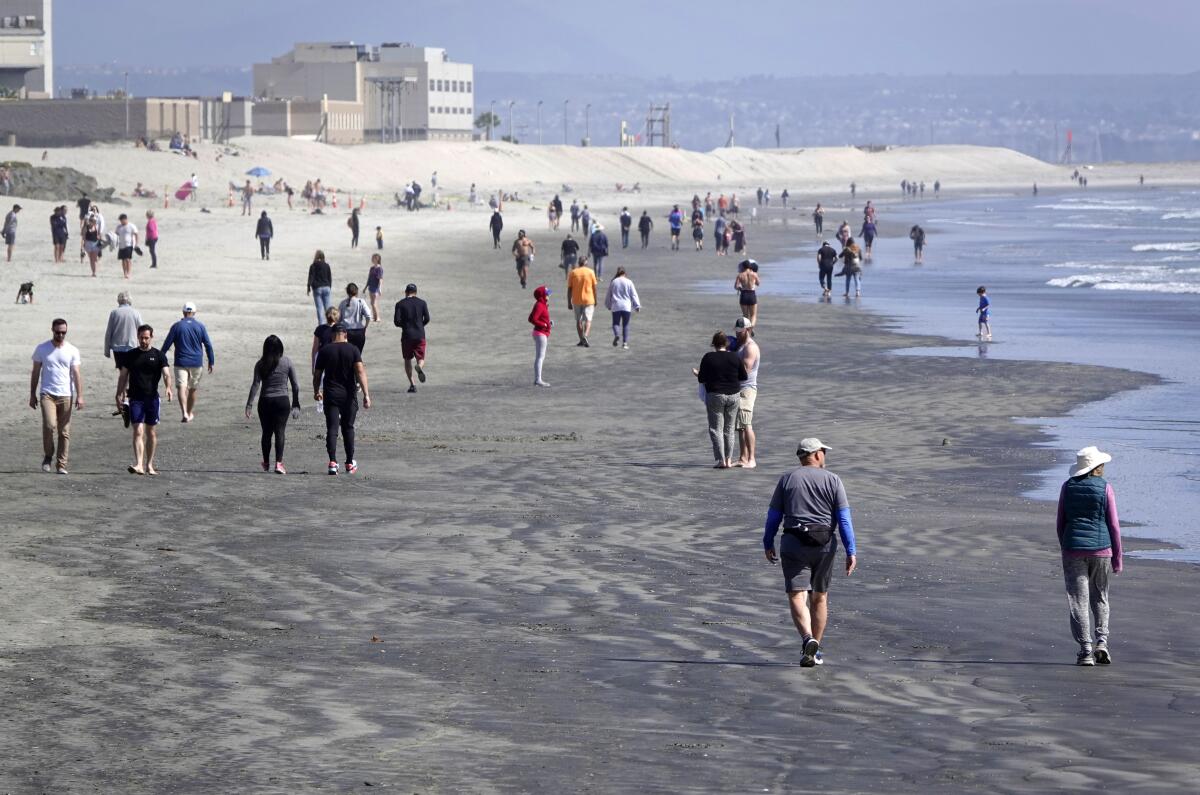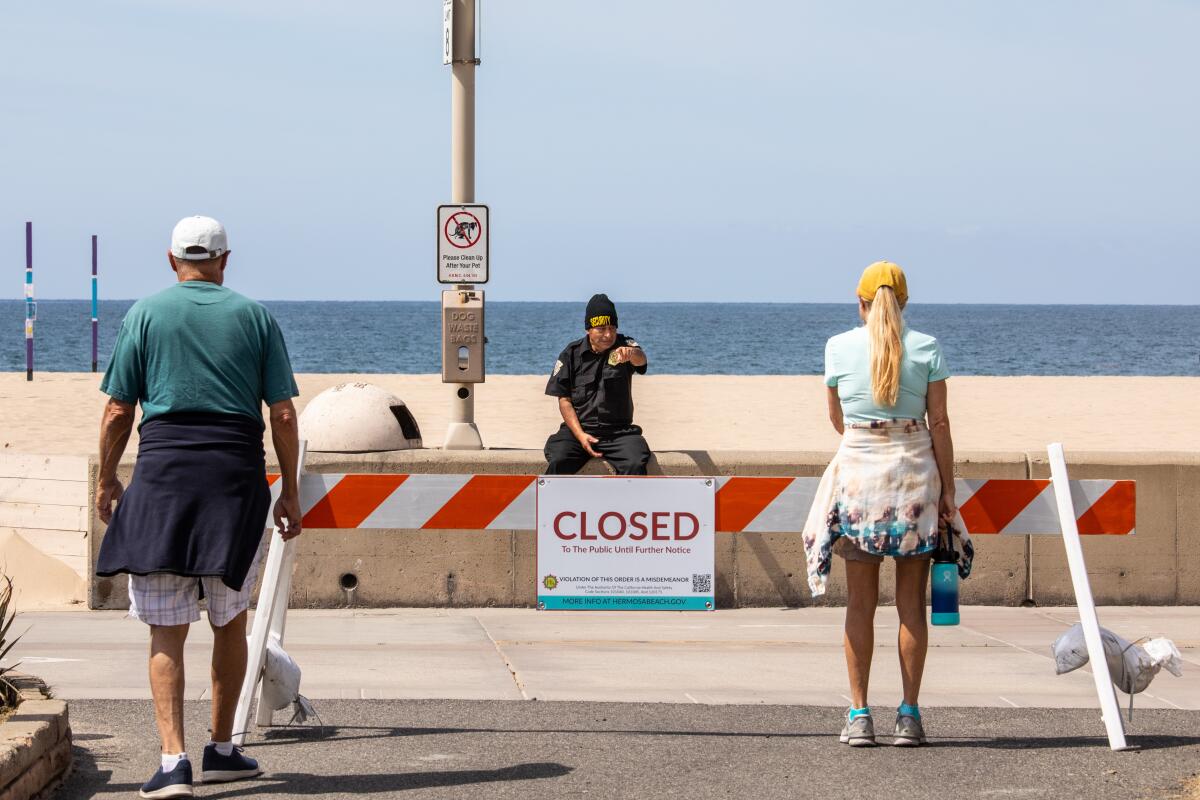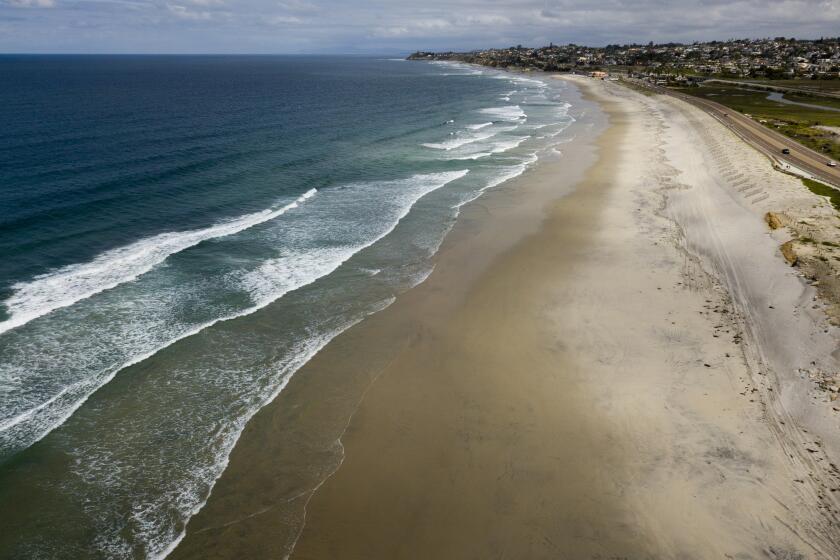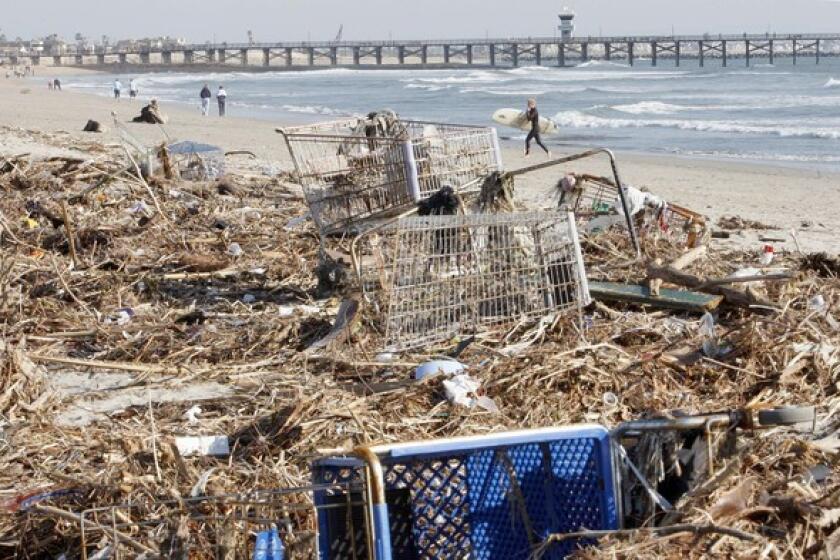Scientists are unsure of coronavirus effects at the beach

Kim Prather, a leading atmospheric chemist at the Scripps Institution of Oceanography, wants to yell out her window at every surfer, runner, and biker she spots along the San Diego coast.
“I wouldn’t go in the water if you paid me $1 million right now,” she said.
The beach, in her estimation, is one of the most dangerous places to be these days, as the novel coronavirus marches silently across California.
Many beachgoers know they can suffer skin rashes, stomach illness and serious ear and respiratory infections if they go into the water within three days of a heavy rain, because of bacteria and pathogens washing off roads and into the ocean. Raw or poorly treated sewage entering the ocean also poses major health risks.
Prather fears that SARS-CoV-2, the virus that causes COVID-19, could enter coastal waters in similar ways and transfer back into the air along the coast.
In her research, Prather has found that the ocean churns up all kinds of particulate and microscopic pathogens, and every time the ocean sneezes with a big wave or two, it sprays these particles into the air. She believes that this new coronavirus is light enough to float through the air much farther than we think. The six-feet physical distancing rule, she said, doesn’t apply at the beach, where coastal winds can get quite strong and send viral particles soaring.
“It’s not going to kill you if you miss a few surfing sessions, but it could if you go out there and get in the wrong air,” she said.
“You can’t see the virus, you can’t smell it ... It’s a real silent killer right now.”
A scientist who angered surfers when she warned of potential coronavirus threats in sea spray reassesses the danger amid new research.
Scientists across the globe are scrambling to learn the basic characteristics of the virus, and so far, neither the World Health Organization, the U.S. Centers for Disease Control and Prevention nor local health agencies have warned that the virus can be spread by ocean spray or coastal breezes. However, they have warned that it can be spread by droplets from sneezes and coughs, and by coming into contact with it on surfaces.
And though the virus has been detected in sewage, scientists are still investigating whether it remains infectious in fecal matter — and whether it survives treatment in a wastewater facility.

In the eyes of California health officials, beaches pose a health threat by drawing large crowds of people who will congregate too closely and trigger a chain of infections.
It hasn’t been easy keeping Californians off the beach even with those concerns, despite stay-at-home orders and officials urging the public to avoid crowding popular areas. By now most beaches, trails and parks in California have been roped off in an effort to slow the spread of COVID-19, which has overwhelmed hospitals and escalated medical emergencies across the nation and world.
Even the Coastal Commission, usually the gatekeeper of California’s landmark law that declares access to the beach is a fundamental right, is allowing local officials to put up temporary signs and barricades — citing the emergency need to protect public health and safety.
Patrol cars and loudspeakers can be heard blasting social distancing rules along Ocean Avenue in Santa Monica. In Manhattan Beach, a surfer was slapped with a $1,000 fine after he ignored numerous warnings by police and lifeguards cautioning him not to go in the water.

Prather, who directs the Center for Aerosol Impacts on Chemistry of the Environment, a large research hub at Scripps backed by $40 million from the National Science Foundation, sent her researchers and students home long before California officials issued stay-at-home orders. She suspected this virus was contagious by air, and knew from past studies that coronaviruses can be excreted in fecal matter. She worries SARS-CoV-2 could enter the ocean from sewage spills and outfalls, and then reenter the atmosphere.
Wastewater treatment plants don’t necessarily deactivate viruses before sending the sewage into the ocean — they tend to target bacteria like E. Coli, she said. And in areas like Imperial Beach, sewage from the Tijuana River often spills into the ocean completely untreated.
Coronaviruses are encased by what she calls a “hydrophobic” lipid, or fatty, membrane. Fat tends to float to the surface of water, similar to oil in a vinaigrette dressing. When waves break in the surf zone and all the foam and bubbles pop, Prather said, “all that stuff — the viruses, the bacteria, pollutants, all the gooey, oily stuff — just launches into the air.”
The ocean, in fact, is the largest natural source of aerosol particles after dust. These marine aerosols affect the formation of clouds over the ocean and can spread over large distances.
Once in the air, studies have shown that aerosols can travel around the globe in as little as two weeks. Prather has found dust in microbes from Africa that changed the snowfall in California. She’s been tracing the bacteria and sewage pollution dumped into the ocean from the Tijuana River, showing how much ends up transferring to the atmosphere.
“Once things are in the air, they can go pretty darn far. People are shocked whenever I talk about stuff becoming airborne,” she said. “I see pictures of the beach shut down, and the signs tell you don’t walk on the beach, don’t swim, don’t surf, but nobody tells you: Don’t breathe.”
Scientists are still debating the characteristics of this latest coronavirus. Recent research in the New England Journal of Medicine found that when the virus was suspended in a mist under laboratory conditions, it remained “viable and infectious” for three hours — though researchers have said that time period would probably be no more than half an hour in real-world conditions.
Charles Gerba, a professor of microbiology at the University of Arizona who has studied coronaviruses in wastewater since the SARS outbreak, said these kinds of viruses have typically been found to survive two or three days in raw sewage.
With this new coronavirus, he’s done a few molecular tests: Though he’s confirmed that the virus does wind up in sewage, he found that more than 90% of this new coronavirus was removed by typical wastewater treatment —“it’s very sensitive to disinfectants.”
Still up for debate, however, is whether the virus in the sewage is still infectious.
“One report says yes, another report says no, so we don’t really know yet for certain,” said Gerba, whose research focuses on wastewater removal of viral pathogens. As for how long the virus could survive in saltwater, there’s not much data, he said, but pathogens like hepatitis A or norovirus tend to survive much longer in wild environments.
Here’s what we know so far about the statewide spread of the virus that causes COVID-19.
For Prather, she hopes to fill in more data gaps and is preparing to test the air particles along the coast for signs of the virus — especially in areas known for inconsistent water quality.
“People kept saying respiratory droplets and surfaces, surfaces, surfaces, but I just felt like no way, this is something special,” she said. “This thing is so contagious …. Look at that choir in Washington — those people weren’t coughing. They were just singing! But it got so many of them.”
In the meantime, California beaches are likely to remain close to empty. Even beach advocacy groups have joined the Coastal Commission in urging people to avoid crowding the beaches and ocean. Fresh air and connecting with the outdoors are important, they said, but these are extraordinary times.
Some people worry the temporary closures could lead to permanent beaches behind lock and key — public beach access, after all, has been a contentious battle along the coast for decades. Coastal officials say they’ve been keeping track of which beaches have closed, and city and county leaders have been told that access restrictions expire immediately whenever shelter-in-place orders are lifted.
“We recognize there is an inequity in coastal access and we strongly encourage local governments to consider approaches that balance public health order requirements and equitable public access — the coast belongs to all,” Jack Ainsworth, the coastal commission’s executive director, wrote in a letter to local officials.
After another back-to-back cold front that pelted rain, heavy snow and even a tornado warning down onto Southern California, here are some precautions and commonly asked questions about whether it’s safe to go to the beach.
Surfrider Foundation, one of the most passionate public access groups in California, assured beachgoers that they will be out in full force once the restrictions are lifted to ensure that no oceanfront property owners took advantage of this unprecedented situation.
“We in California have fought for open beaches for decades,” said Jennifer Savage, Surfrider’s policy manager in California. “But we also believe in being responsible citizens and protecting the health and safety of our community.
“Right now, you can be the difference between life and death for somebody you don’t know.”
More to Read
Sign up for Essential California
The most important California stories and recommendations in your inbox every morning.
You may occasionally receive promotional content from the Los Angeles Times.















